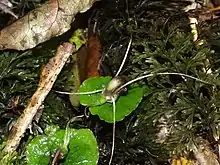Corybas acuminatus
Corybas acuminatus, commonly known as the dancing spider orchid[2] or helmet flower,[3] is a species of terrestrial orchid endemic to New Zealand. It has a triangular, sharply pointed leaf and a small translucent, greenish-white flower with purple markings and with very long sepals. It is found on both the main islands of New Zealand and also some of the off-shore islands.
| Dancing spider orchid | |
|---|---|
 | |
| Corybas acuminatus on Mt. Maungatautari | |
| Scientific classification | |
| Kingdom: | Plantae |
| Clade: | Tracheophytes |
| Clade: | Angiosperms |
| Clade: | Monocots |
| Order: | Asparagales |
| Family: | Orchidaceae |
| Subfamily: | Orchidoideae |
| Tribe: | Diurideae |
| Genus: | Corybas |
| Species: | C. acuminatus |
| Binomial name | |
| Corybas acuminatus | |
| Synonyms[1] | |
Description
Corybas acuminatus is a terrestrial, perennial, deciduous, herb with a single triangular to heart-shaped leaf up to 40 mm (2 in) long and 20 mm (0.8 in) wide with a sharply pointed tip. The leaf is light green on the upper surface and silvery with red veins on the lower side. A single more or less translucent flower with dull red striations arises directly above the leaf. The largest part of the flower is the dorsal sepal which is up to 40 mm (2 in) long with a long, horizontal, thread-like tip. The lateral sepals are erect, thread-like and are up to 60 mm (2 in) longer than the flower. The petals are similar to the lateral sepals although smaller and are held horizontally or turn downwards. The labellum is red and creamy green and has two rounded ear-like shapes near its base. Flowering occurs from August to December.[2][3][4]
Taxonomy
Corybas acuminatus was first formally described in 1991 by Mark Clements and Edwin Hatch from a specimen collected near Karekare and the description was published in the New Zealand Journal of Botany.[1] The specific epithet (acuminatus) is a Latin word meaning "pointed" or "sharpened",[5] referring to the shape of the leaf of this orchid.[4]
In 2002, David Jones and Mark Clements proposed splitting Corybas into smaller genera and placing this species into Nematoceras but the change has not been widely accepted.[6][7]
Distribution and habitat
The dancing spider orchid grows in moist, shady forests. It occurs on the North, South, Stewart, Chatham and Auckland Islands.[2][3][4]
Conservation
Corybas acuminatus is classified as "not threatened" by the New Zealand Government Department of Conservation.[3]
References
- "Corybas acuminatus". World Checklist of Selected Plant Families (WCSP). Royal Botanic Gardens, Kew.
- "Corybas acuminatus". New Zealand Native Orchid Group. Retrieved 4 May 2018.
- de Lange, Peter. "Corybas acuminatus". New Zealand Plant Conservation Network. Retrieved 4 May 2018.
- Clements, Mark A.; Hatch, Edwin D. (July 1985). "Corybas acuminatus (Orchidaceae) — a new name for the species previously considered to be Corybas rivularis". New Zealand Journal of Botany. 23 (3): 491–494. doi:10.1080/0028825X.1985.10425349.
- Brown, Roland Wilbur (1956). The Composition of Scientific Words. Washington, D.C.: Smithsonian Institution Press. p. 68.
- Jones, D.L. (2002), "Nomenclatural notes arising from studies into the tribe Diurideae (Orchidaceae)", Orchadian, 13: 436–468
- "Corybas acuminatus". APNI. Retrieved 4 May 2016.
